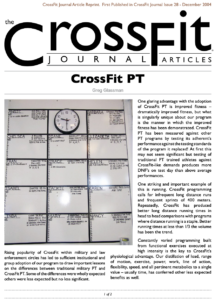By Greg Glassman
Rising popularity of CrossFit within military and law enforcement circles has led to sufficient institutional and group adoption of our program to draw important lessons on the differences between traditional military PT and CrossFit PT. Some of the differences were wholly expected others were less expected but no less significant.
One glaring advantage with the adoption of CrossFit PT is improved fitness – dramatically improved fitness, but what is singularly unique about our program is the manner in which the improved fitness has been demonstrated. CrossFit PT has been measured against other PT programs by testing its adherent’s performance against the testing standards of the program it replaced! At first this may not seem significant but testing of traditional PT trained athletes against CrossFit-like demands produces more DNF’s on test day than above average performances.
One striking and important example of this is running. CrossFit programming calls for infrequent long distance runs and frequent sprints of 400 meters. Repeatedly, CrossFit has produced better long distance running times in head to head comparisons with programs where distance running is a staple. Better running times at less than 1/3 the volume has been the trend.
Constantly varied programming built from functional exercises executed at high intensity is the key to CrossFit’s physiological advantage. Our distillation of load, range of motion, exercise, power, work, line of action, flexibility, speed, and all pertinent metabolics to a single value – usually time, has conferred other less expected benefits as well.
With CrossFit PT every workout provides a useful data point. We collect relative and absolute performance measures every single workout. Measurement is important and no PT program we know of offers as many opportunities for metrics as CrossFit. The information that can be mined from an individual’s, team’s, or company’s performance is incredible, invaluable, and generally not available with traditional PT.
Distillation of every workout to a single value turns PT into sport. Relative and absolute measures readily convert to “points”, and “men will die for points”. Colonel Jeff Cooper observed in “Principles of Personal Defense” that, “fear of sporting failure is usually greater than the fear of death.” We routinely watch warriors push themselves harder for a “win” or “placing” than any coach would ever consider wise or prudent to push the athlete. Our scoreboards (whiteboards) inspire each round of competitors to ask, “What are we doing today?” “Who did what?” and then internally, “What do I have to do to take it?”

Our police academy graduates ask to come back for PT after graduation and soldiers ask for PT on weekends. CrossFit is fun, the kind of fun that can boost morale and save lives – Army Captain Michael Perry offered among the benefits of his men’s first 5 months of CrossFit that, “first and most importantly lifelong friendships forged from extreme physical and mental challenges. Rarely does a day go by without laughter and agony which must be the recipe for strong camaraderie.”
One surprising result of the deliberate and public performance ranking for each workout has been the motivation and acceleration of improvement of those less physically capable by temperament, training, or natural limitation. Ranking has seemingly done more for bottom performers than top performers.
Our reliance on functional movements, including many presumed too complex or technical for mass application, has returned skill to PT. Over the past 60 years traditional PT has been flensed of nearly all skill elements that train for coordination, accuracy, agility, and balance. The costs here are enormous and extend to losses in speed and power as well producing an athlete generally less capable of dealing with variances and vagaries of opponents, movement, and terrain.
The skill elements included in CrossFit PT further the sense of sport that so motivates men. CrossFit PT feels like sport; traditional PT at even lower intensities feels like punishment.
Our use of functional movements has also reduced the chronic overuse injuries that plague traditional PT program participants. Injuries to the back and knees, shin splints, and other “sick day” maladies have been greatly reduced with implementation of CrossFit.
Finally, the intensity of our workouts was designed with the sole objective of maximizing adaptation. One critical side benefit has been a dramatic reduction in PT training time while greatly improving the payout.
Where tested, CrossFit PT has been shown to be a dramatic improvement to traditional PT in these regards:
- Efficacy
- Time required
- Safety
- Fun
- Motivation
- Testing/metrics
- Psychological demands
- Battlefield/street engagement
This article, by BSI’s co-founder, was originally published in The CrossFit Journal. While Greg Glassman no longer owns CrossFit Inc., his writings and ideas revolutionized the world of fitness, and are reproduced here.
Coach Glassman named his training methodology ‘CrossFit,’ which became a trademarked term owned by CrossFit Inc. In order to preserve his writings in their original form, references to ‘CrossFit’ remain in this article.
- Download Original PDF
- Download Español (Spanish) PDF
- Download Português (Portuguese) PDF
- Download Italiano (Italian) PDF
- Download Français (French) PDF
Greg Glassman founded CrossFit, a fitness revolution. Under Glassman’s leadership there were around 4 million CrossFitters, 300,000 CrossFit coaches and 15,000 physical locations, known as affiliates, where his prescribed methodology: constantly varied functional movements executed at high intensity, were practiced daily. CrossFit became known as the solution to the world’s greatest problem, chronic illness.
In 2002, he became the first person in exercise physiology to apply a scientific definition to the word fitness. As the son of an aerospace engineer, Glassman learned the principles of science at a young age. Through observations, experimentation, testing, and retesting, Glassman created a program that brought unprecedented results to his clients. He shared his methodology with the world through The CrossFit Journal and in-person seminars. Harvard Business School proclaimed that CrossFit was the world’s fastest growing business.
The business, which challenged conventional business models and financially upset the health and wellness industry, brought plenty of negative attention to Glassman and CrossFit. The company’s low carbohydrate nutrition prescription threatened the sugar industry and led to a series of lawsuits after a peer-reviewed journal falsified data claiming Glassman’s methodology caused injuries. A federal judge called it the biggest case of scientific misconduct and fraud she’d seen in all her years on the bench. After this experience Glassman developed a deep interest in the corruption of modern science for private interests. He launched CrossFit Health which mobilized 20,000 doctors who knew from their experiences with CrossFit that Glassman’s methodology prevented and cured chronic diseases. Glassman networked the doctors, exposed them to researchers in a variety of fields and encouraged them to work together and further support efforts to expose the problems in medicine and work together on preventative measures.
In 2020, Greg sold CrossFit and focused his attention on the broader issues in modern science. He’d learned from his experience in fitness that areas of study without definitions, without ways of measuring and replicating results are ripe for corruption and manipulation.
The Broken Science Initiative, aims to expose and equip anyone interested with the tools to protect themself from the ills of modern medicine and broken science at-large.
Support the Broken Science Initiative.
Subscribe today →




